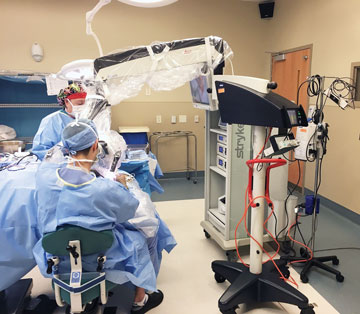A better option — and one Ms. Fredette's staff also employs — is placing fluid-wicking devices around the surgical table to keep the floor dry and safe for surgical team members.
Slipping is just one risk surgical teams face during busy days is bustling facilities when their attention is often on paperwork, patient care and pulling supplies — everything but where they're walking, which they often do quickly. A stray
cord or misplaced piece of equipment could be enough to trip up a hustling staff member.
Tripping risks have increased as cases continue to shift to outpatient ORs, which are often packed with the latest devices and equipment needed to perform procedures that are growing in complexity. Rolling in extra equipment can clutter walking
lanes and limit maneuverability around the table, creating congestion that puts staff at risk if they don't watch where they're going.
Consolidating equipment is the simplest way to keep floors clear of tripping hazards, says Anjali Joseph, PhD, EDAC, director of the Center for Health Facilities Design and Training at Clemson (S.C.) University. Dr. Joseph is involved in a project
funded by the Agency for Healthcare Research and Quality to reimagine current OR designs with the goal of creating safer spaces. She spends a lot of time watching surgical teams in action and asking them about their ergonomic needs. "OR clutter
is a big concern based on our observations and conversations," says Dr. Joseph.
She points to several space-saving solutions that can help keep walkways clear in ORs where every square foot is valuable real estate:
- Equipment booms. Floor- or ceiling-mounted booms limit the number of video towers and equipment carts needed around the surgical table. Booms also let you adapt to evolving equipment needs by easily changing the configuration
of ORs over time. "But booms present their own challenges," says Dr. Joseph. "They're expensive, staff often bump their heads on mounted screens and equipment never quite aligns as well as you'd like."
If booms aren't in your budget or are an impractical add, Dr. Joseph suggests making sure equipment carts and instrument tables are out of high-traffic areas and away from the pathway where patients are wheeled into and out of ORs. Also be sure
to position carts in large enough spaces where open doors won't obstruct pathways of movement.
- Divided rooms. Dr. Joseph also says organizing ORs into four work areas — anesthesia at the head of the table, sterile zones on both sides of the table and a circulation zone outside the sterile field — ensures
staff work in dedicated areas, keeps their steps to a minimum and limits movement during cases, which reduces the risk of trips and collisions.
.svg?sfvrsn=be606e78_3)


.svg?sfvrsn=56b2f850_5)